Does Your Gua Sha Stone Actually Matter? A Pro’s Honest Guide
I’ve been a licensed esthetician for a long, long time—over fifteen years, focusing on holistic skincare and hands-on techniques. In that time, I’ve seen beauty trends explode and then fizzle out. But Gua Sha? That one’s different. It has stuck around for a very good reason. But honestly, I’ve also seen a ton of confusion. Clients will show me these beautiful, sometimes very expensive tools, and have zero idea how to use them. Even worse, some have been digging in with way too much pressure and making their skin angry.
In this article
So, they always ask me the big question: “Does the type of stone really matter?”
The simple answer is yes, it absolutely does. But probably not for the reasons you’ve seen all over social media. While the traditional energetic properties of the stones are a beautiful part of this practice’s history, the real, tangible differences come down to physics. It’s all about how the material feels in your hand and on your skin—its weight, how well it holds a cold temperature, and its unique surface texture.
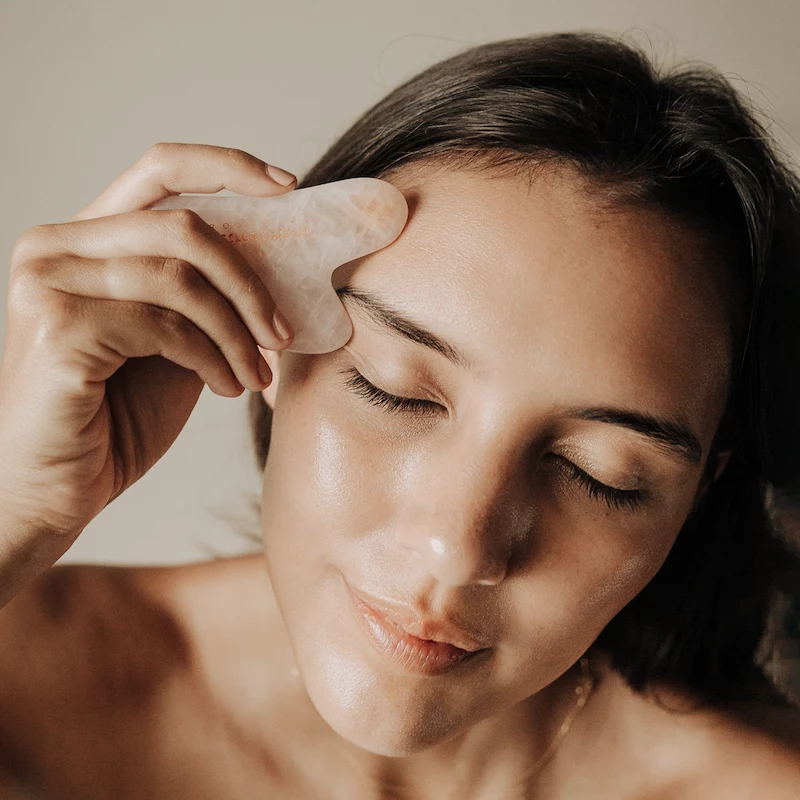
This guide is basically a brain dump of everything I’ve learned in the treatment room. I’ve used pretty much every type of Gua Sha tool out there, and I want to cut through the hype and help you find the right one for your own routine.
Why the Material Makes Such a Big Difference
Before we get into specific stones, you need to understand what’s actually happening when you use one of these tools correctly. It’s not just rubbing a rock on your face; it’s a smart technique that can seriously impact your skin’s health.
Cosmetic Gua Sha really works on three levels:
- Moving Stagnant Fluid: Think of your lymphatic system as the body’s garbage disposal network. But here’s the thing—it doesn’t have a pump. It relies on muscle movement to work. The gentle, sweeping motion of Gua Sha manually pushes along stagnant lymph fluid, which is what helps de-puff your face, especially around the eyes and jaw.
- Releasing Facial Tension: You know that web of connective tissue that wraps around every muscle? That’s fascia. When we’re stressed, we hold tension in our jaw, brows, and neck, and that fascia gets tight. Over time, this can actually contribute to fine lines. A good tool can gently stretch and release that tightness.
- Boosting Circulation: That light gliding pressure brings a rush of fresh blood and oxygen to the surface of the skin. We’re not talking about aggressive, angry red marks here. It’s a healthy, temporary flush that nourishes your skin cells and gives you an immediate, visible glow.
So, how does the tool’s material play into this? It’s everything.
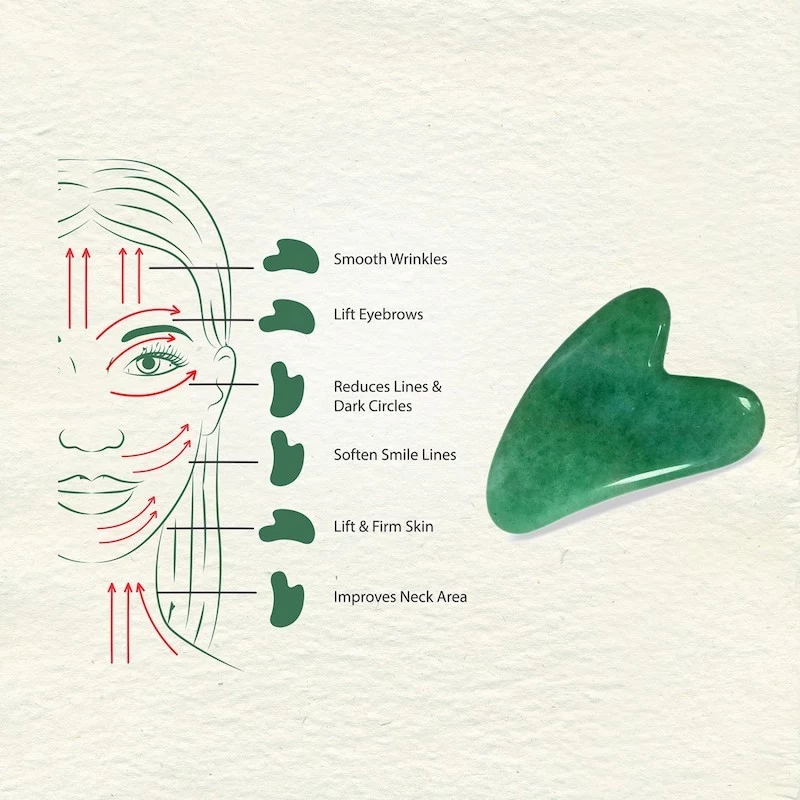
- Temperature: How well a material holds cold is a huge deal. Stones like jade and rose quartz are naturally cool to the touch, which is amazing for calming inflammation and constricting blood vessels to reduce puffiness. By the way, stainless steel is the king of cold—it gets chilly fast and stays that way longer, making it a powerhouse for de-puffing.
- Weight: A heavier tool, like a quality Bian stone, basically does some of the work for you. Its natural weight provides consistent pressure without you needing to push. This is a game-changer for releasing deep tension in your jaw. Lighter tools, like rose quartz, give you more nimble control for delicate spots like under your eyes.
- Texture & Glide: A super-smooth surface, like you’d find on quartz or steel, glides like a dream with the right amount of oil. But some materials, like nephrite jade, have a slightly different texture that gives it a subtle “grip” on the fascia. This can be fantastic for lifting and sculpting, but you have to be careful not to drag the skin.
- Hygiene (This is a big one!): Some materials are porous, meaning they have microscopic holes that can trap oil and bacteria. Lower-quality jades can sometimes be porous, and if you aren’t cleaning them like a surgeon, they can lead to breakouts. Non-porous options like high-quality quartz, Bian stone, and stainless steel are way easier to keep sanitary, which is why a lot of pros prefer them.
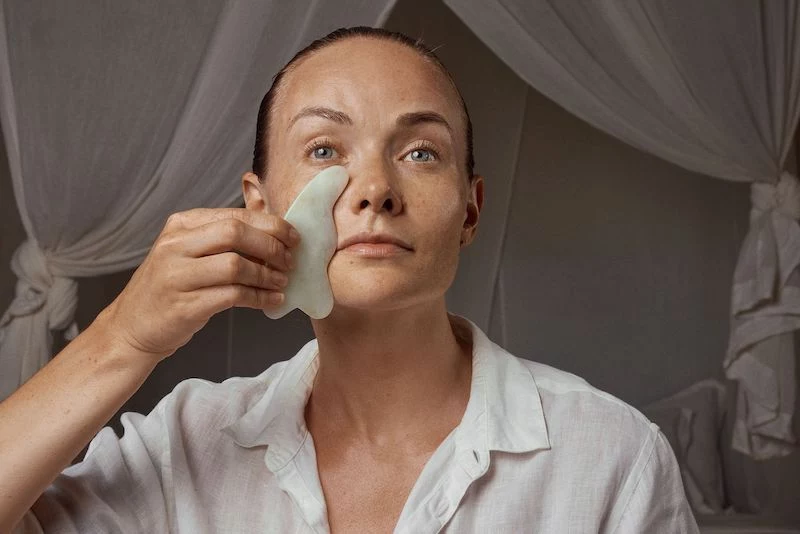
Breaking Down the Most Common Materials
Alright, let’s get into the nitty-gritty. I’ve used all of these extensively, so here’s my honest take on what they’re like to work with.
Bian Stone: The Original Heavy-Hitter
This is considered the OG material for therapeutic Gua Sha. It’s a composite stone packed with minerals, and in my book, it’s the heavyweight champion.
It feels incredibly unique—dense, substantial, and with an almost buttery texture. It warms up as you use it, which feels incredible for melting away deep muscle knots. Because of its weight, it’s my go-to for serious tension, especially for TMJ issues or tight shoulders. Heads up, though: this is a premium material. A real Bian stone tool will run you anywhere from $60 to $120+. If you see one for $20, I can almost guarantee it’s just a plain black stone and not the real deal. Always buy from a supplier who is transparent about the stone’s origin.
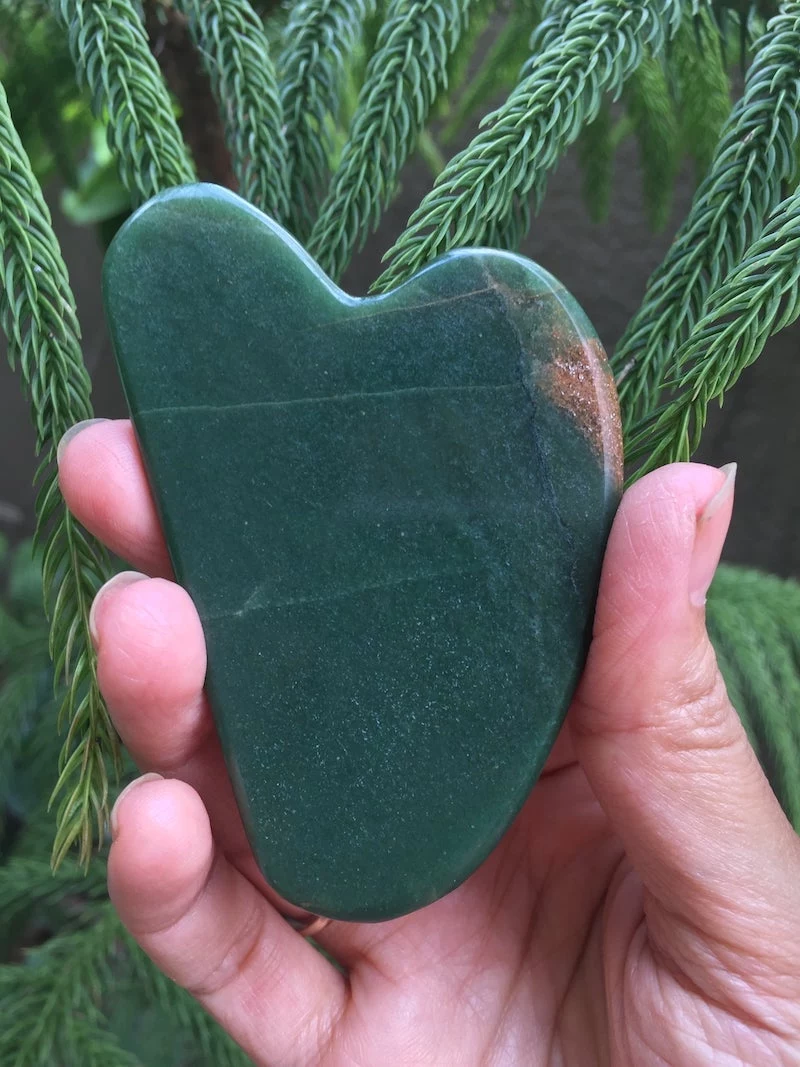
- Best For: Therapeutic benefits, deep tension release, and anyone who wants the most traditional experience.
- Durability: Very durable.
Nephrite Jade: The All-Around Workhorse
When people talk about traditional jade, they usually mean nephrite. It’s much tougher and more durable than the more common, fragile jadeite.
I love nephrite because it has this wonderful smoothness but with a subtle drag that’s perfect for grabbing the fascia to create a lifting effect. It’s a fantastic, balanced tool that’s suitable for almost any skin type. A high-quality nephrite jade tool is an investment, usually costing between $50 and $80. Be careful with fakes—terms like “Xiuyan Jade” often refer to softer, dyed stones that can cause skin reactions. A quick tip: real nephrite is very hard and shouldn’t be easily scratched by a steel knife. If a seller is cagey about where their jade comes from, that’s a red flag.
- Best For: Anyone wanting a high-quality, all-around tool for both calming and sculpting. A great first “serious” Gua Sha tool.
- Durability: Excellent. It’s a tough stone.
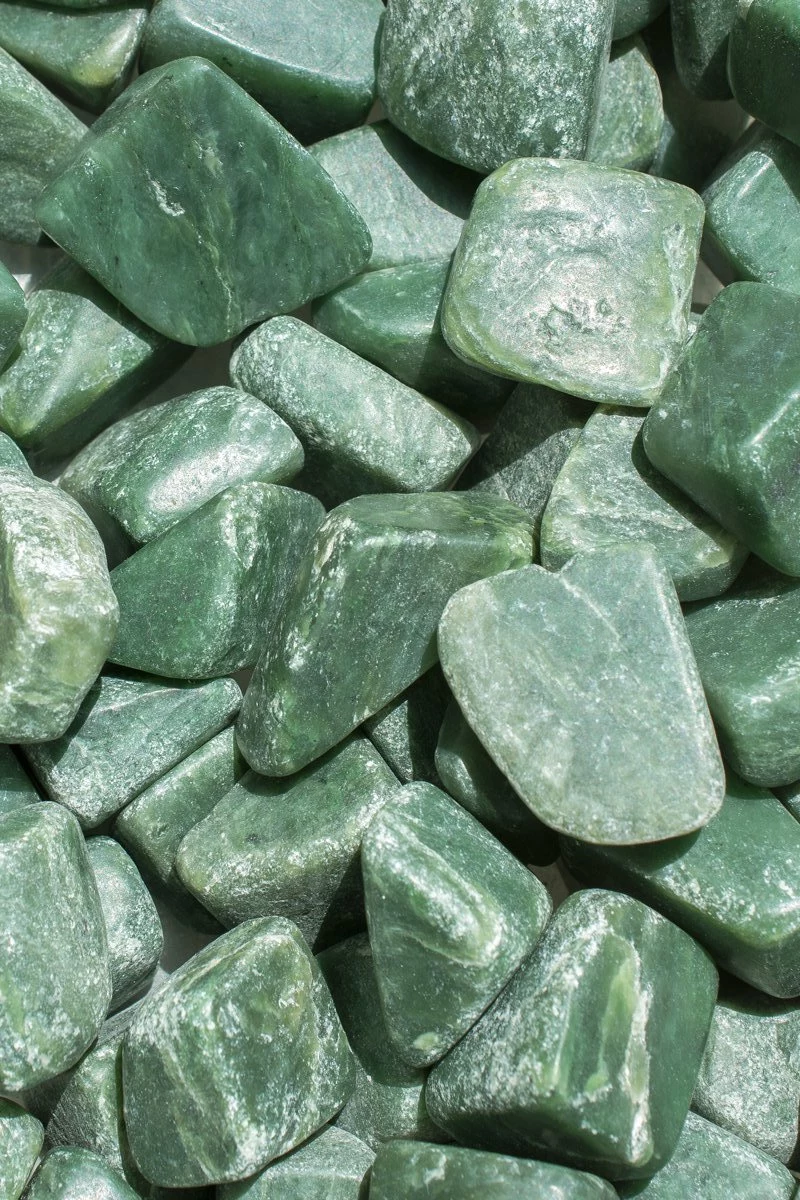
Rose Quartz: The Pretty De-Puffer
Let’s be real, rose quartz is popular mainly because it’s gorgeous. But its properties make it more than just a pretty face. It has a slick, glassy surface and is a champion at holding a cold temperature. I often tell my clients to pop it in the fridge for 10 minutes before using it for an incredible cooling, soothing session. It’s fantastic for skin prone to redness or puffiness.
But I have to give you a serious warning, learned from personal experience. This stone is FRAGILE. I’ve seen more shattered rose quartz tools than I can count. Treat it like it’s made of glass, especially if you have tile floors in your bathroom. One drop and it’s game over. Price-wise, you can find a good one for between $20 and $40.
- Best For: Sensitive or inflamed skin, reducing puffiness, and a calming morning ritual.
- Durability: Poor. It’s very brittle.
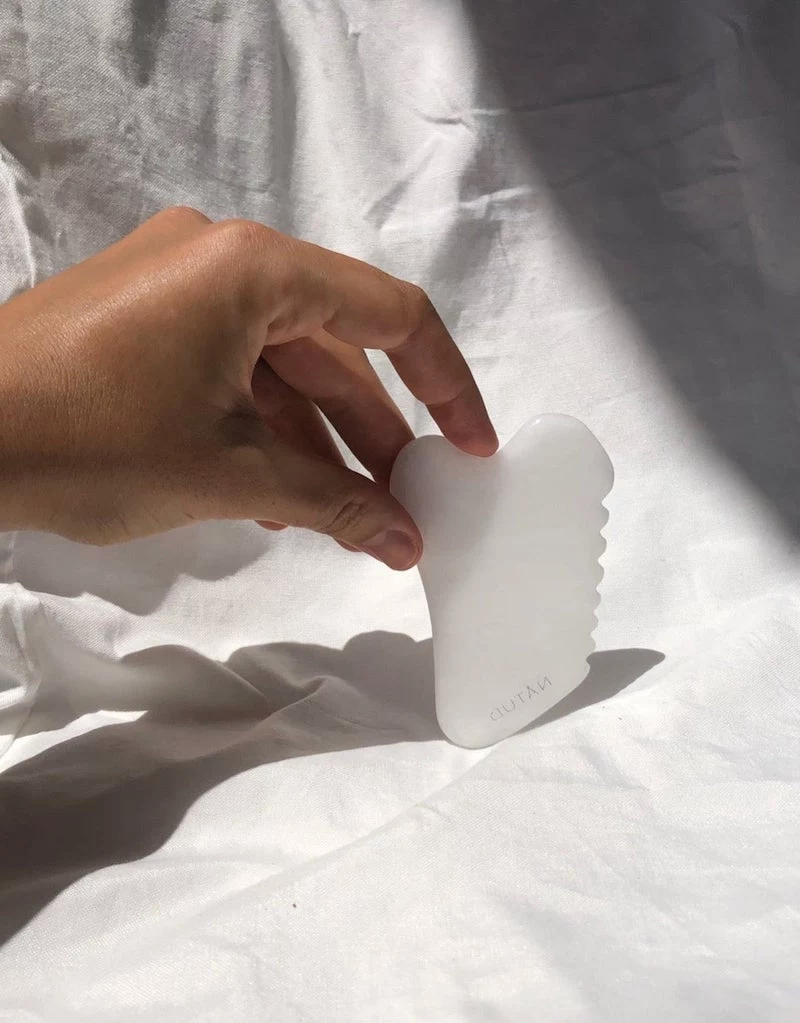
Medical-Grade Stainless Steel: The Modern, Hygienic Choice
This is a newer player in the beauty world, but it’s been used in clinical settings for soft tissue work for ages. As a professional, I have a deep respect for steel. It’s dense, has a satisfying weight, and is virtually indestructible. Plus, it’s completely non-porous and self-cooling—it gets cold in seconds under tap water.
In the treatment room, steel is often my tool of choice because I can perfectly sanitize it between clients. I highly recommend it for anyone who is acne-prone because you can be 100% certain it’s clean, taking one major variable out of the breakout equation. The only downside? It lacks that “natural stone” vibe, which is a totally valid reason to choose something else. Expect to pay $25 to $45 for a quality steel tool.
- Best For: Acne-prone skin, anyone concerned about hygiene, or someone who’s just plain clumsy.
- Durability: Basically indestructible.

Hold On, the Shape Matters Just as Much!
You can buy the most amazing, expensive stone, but if the shape is wrong for your face, it’s basically useless. A well-designed tool should feel like an extension of your hand.
When you’re shopping, look for a tool that has several different edges:
- A long, smooth edge: This is your go-to for big areas like your cheeks and forehead.
- A curved or notched end: This is the part that looks like a little heart or a ‘U’ shape. It’s designed to hug your jawline, cheekbones, and brow bone for sculpting.
- A small tip or corner: Perfect for detailed work around the eyes and nose.
- A comb edge (optional): Some tools have a serrated edge for more intense stimulation. I’d suggest beginners start with a smooth tool and work their way up to this.
Before You Start: Safety, Prep, and a Super Simple Routine
Okay, so you’ve picked your tool. Now what? Using it correctly is key to getting results and avoiding irritation.

Your First Gua Sha Session: A 3-Step Guide
Let’s keep it simple. Here’s how to do your very first session.
- Prep Your Skin: Never, ever use a Gua Sha tool on dry skin. You need slip! Apply 5-7 drops of a facial oil that your skin loves. Jojoba, squalane, and rosehip seed oil are all fantastic options. Make sure you have enough so the tool glides without any pulling or tugging.
- Get the Pressure Right: This is the most common mistake. Cosmetic Gua Sha should NEVER be painful or leave marks. The pressure should be light to medium. A good analogy is that it should feel like you’re spreading frosting on a cake, not scraping burnt toast off a pan. Let the weight of the tool do most of the work.
- The Basic Moves: Hold the tool at a 15- to 30-degree angle to your skin (almost flat). Start at your neck, making gentle upward strokes. Then, move to your jawline, starting from the center of your chin and sweeping up toward your earlobe. Do 3-5 passes on each area.
Quick Win for Busy People: In a rush? Just do 5 upward swipes on each side of your neck and 5 scrapes along your jawline. It takes less than a minute and provides instant tension relief.
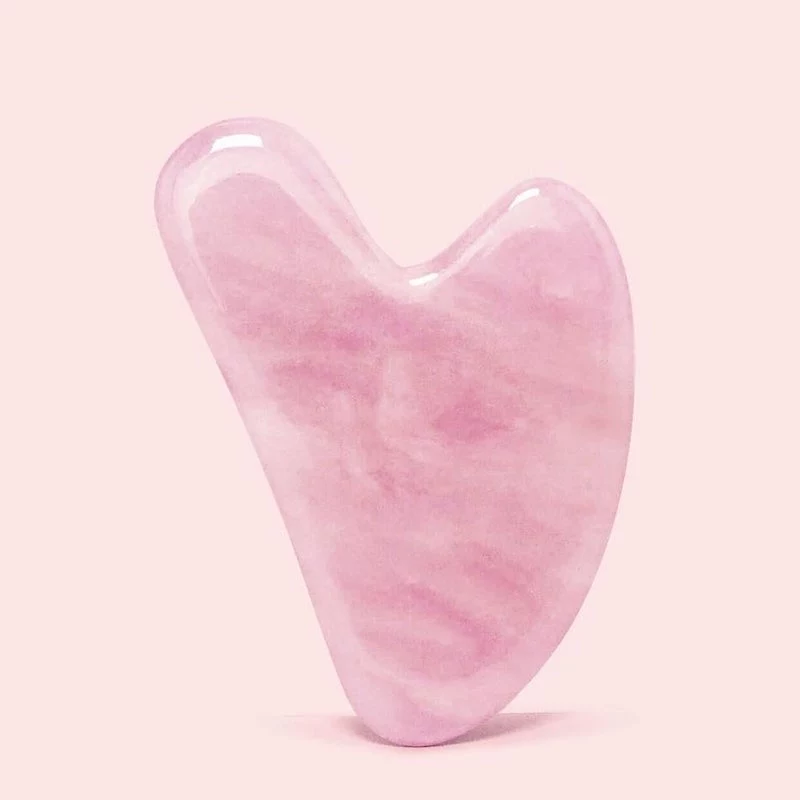
Essential Safety Warnings (Please Read!)
You can do more harm than good if you’re not careful. A gentle flush is normal, but angry red streaks or little red dots (petechiae) mean you’re using way too much pressure.
Do NOT perform Gua Sha over:
- Active, inflamed acne or cystic acne
- Rosacea flare-ups or sunburn
- Any kind of rash, broken skin, or mysterious lesion (see a dermatologist!)
- Oh yeah, and a critical one for modern times: if you get Botox or fillers, you MUST wait before doing Gua Sha. The pressure can make the product migrate. The general rule is to wait at least four weeks, but please, ask your injector first.
Cleaning Is Not Optional
Clean your tool after every single use. For non-porous tools like steel, quartz, and Bian stone, just wash with gentle soap and warm water. For extra sanitation, you can wipe it with 70% isopropyl alcohol. Always dry it completely before putting it away.
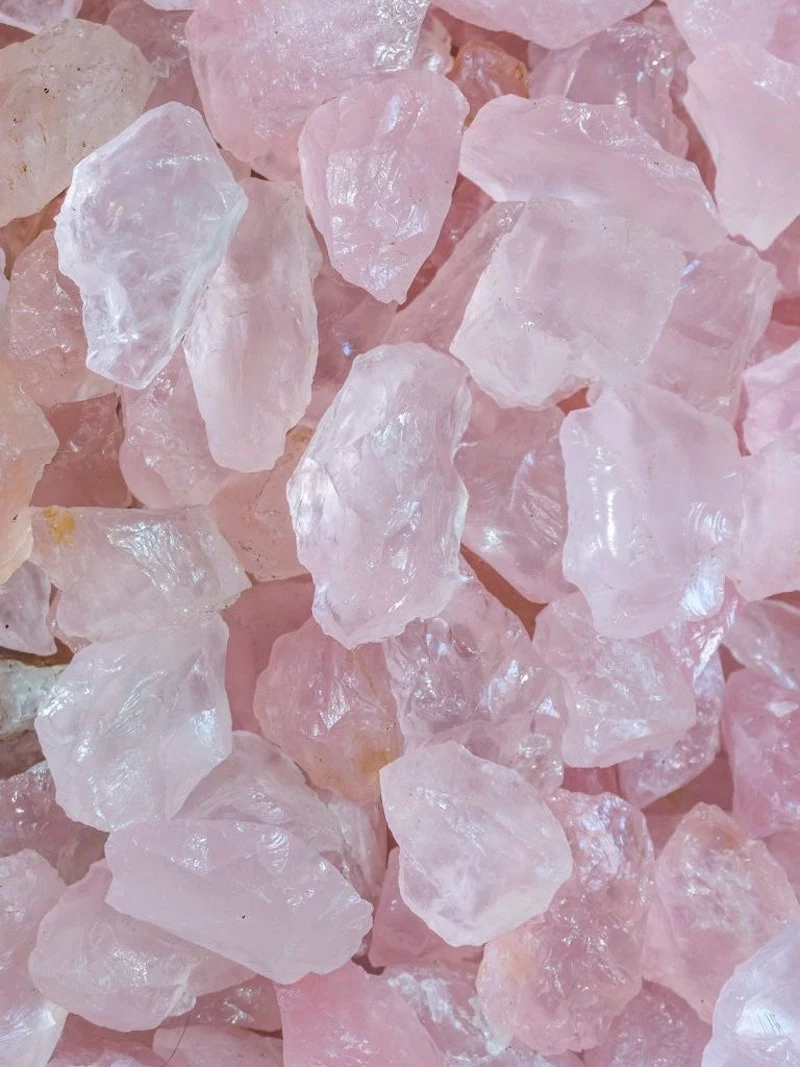
My Final Thoughts
At the end of the day, there is no single “best” stone for everyone. The right choice is deeply personal—it depends on your skin, your goals, and even your lifestyle. If you tend to drop things, a steel tool is a much wiser investment than a fragile quartz one. If your skin is easily inflamed, a cooling stone will serve you better.
So, move past the hype and think about the physical properties. The tool is the hardware, but your technique is the software. A cheap but well-shaped tool, used correctly and consistently, will give you far better results than a $150 stone that just sits on your shelf. The real magic isn’t in the tool itself, but in the mindful care you give yourself.
Inspirational Gallery
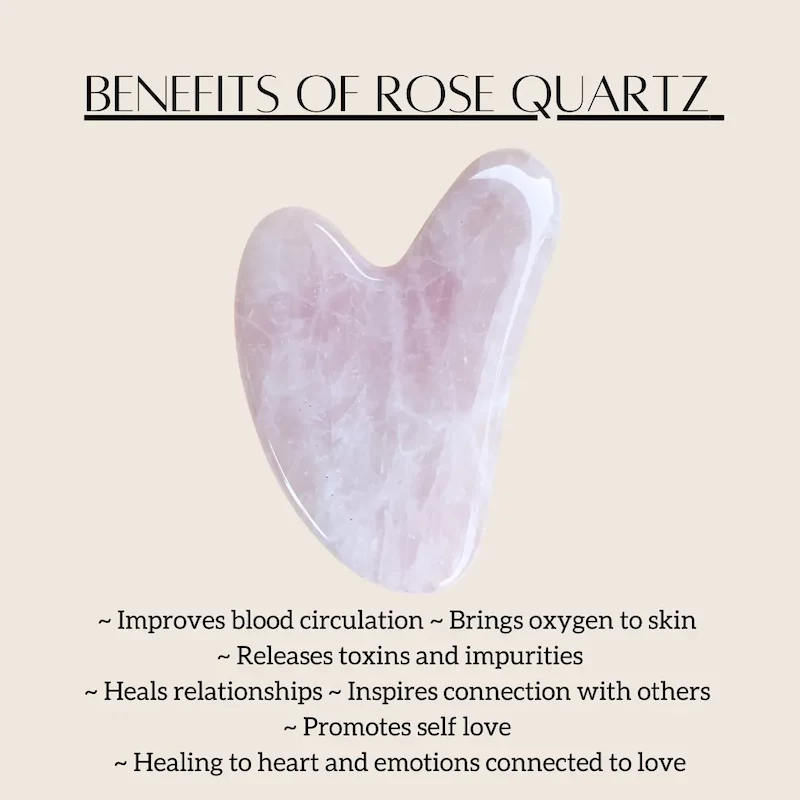
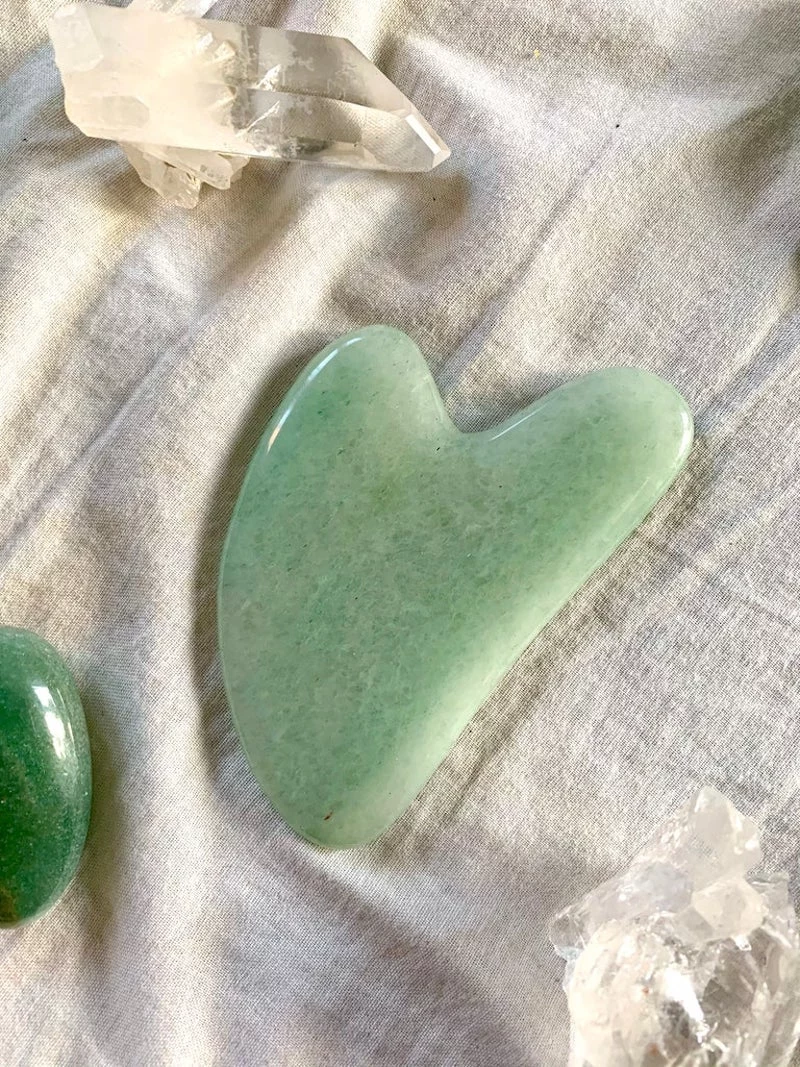
- Reduced morning puffiness, especially under the eyes.
- A more defined and sculpted jawline and cheekbones.
- Softer facial lines born from muscle tension.
The secret to achieving these visible results? Consistency. Just five dedicated minutes each day can create more significant, lasting change than a single, intensive weekly session.
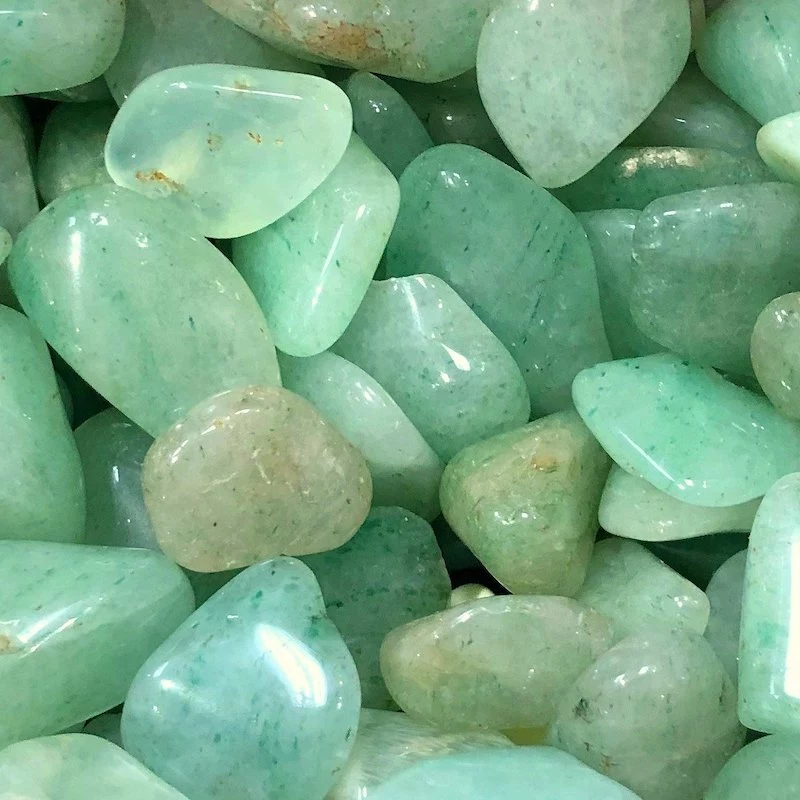
The Golden Rule: Never on Dry Skin. Using your gua sha without enough ‘slip’ from a facial oil or a rich serum doesn’t just feel uncomfortable; it pulls and tugs at the delicate facial skin. This can lead to irritation and broken capillaries. A quality oil, like one with squalane or jojoba, allows the tool to glide effortlessly, making the massage both effective and safe.
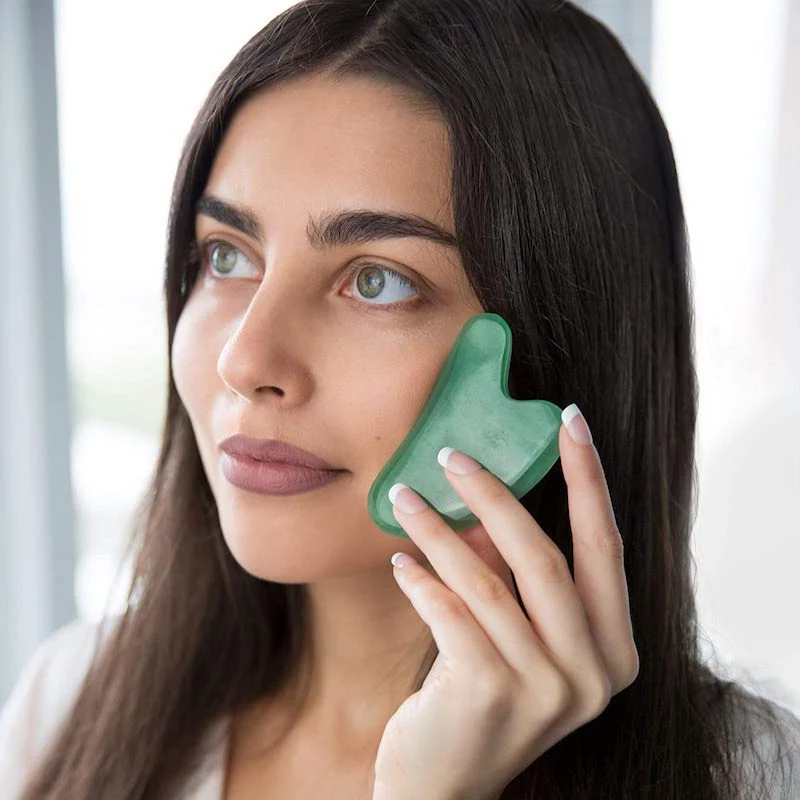
In Traditional Chinese Medicine, the term ‘Gua’ means ‘to scrape,’ while ‘Sha’ describes the temporary, faint redness that signals the movement of stagnant energy and blood.
While cosmetic gua sha is much gentler than the traditional body practice, that subtle pink flush you might see is a great sign! It indicates a healthy increase in circulation, bringing fresh oxygen and nutrients to your skin cells for that coveted post-massage glow.
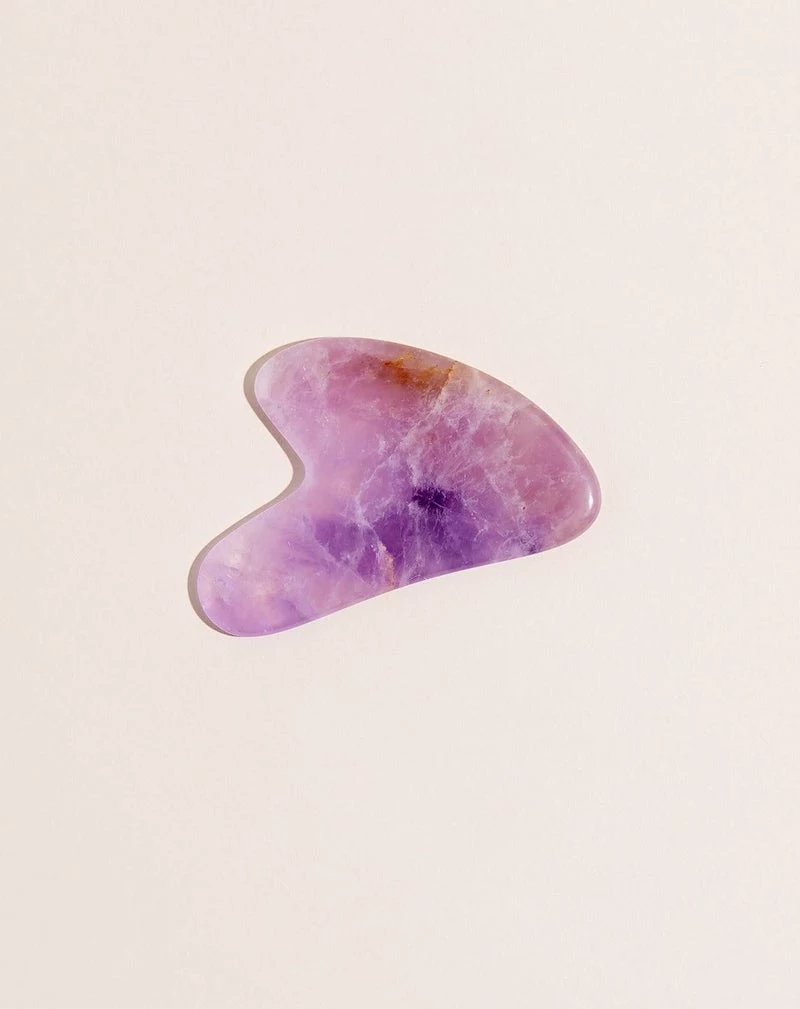
Wondering what shape is best?
The classic heart or wing shape is a fantastic all-rounder, but different contours serve specific purposes. Here’s a quick guide:
- The Long, Straight Edge: Perfect for sweeping across larger areas like the cheeks, forehead, and neck.
- The U-Shaped Notch: Designed to hug the jawline, brow bone, and back of the neck perfectly.
- The Comb Edge: Excellent for targeting fine lines and stimulating areas where you want to boost collagen, like around the mouth and between the brows.
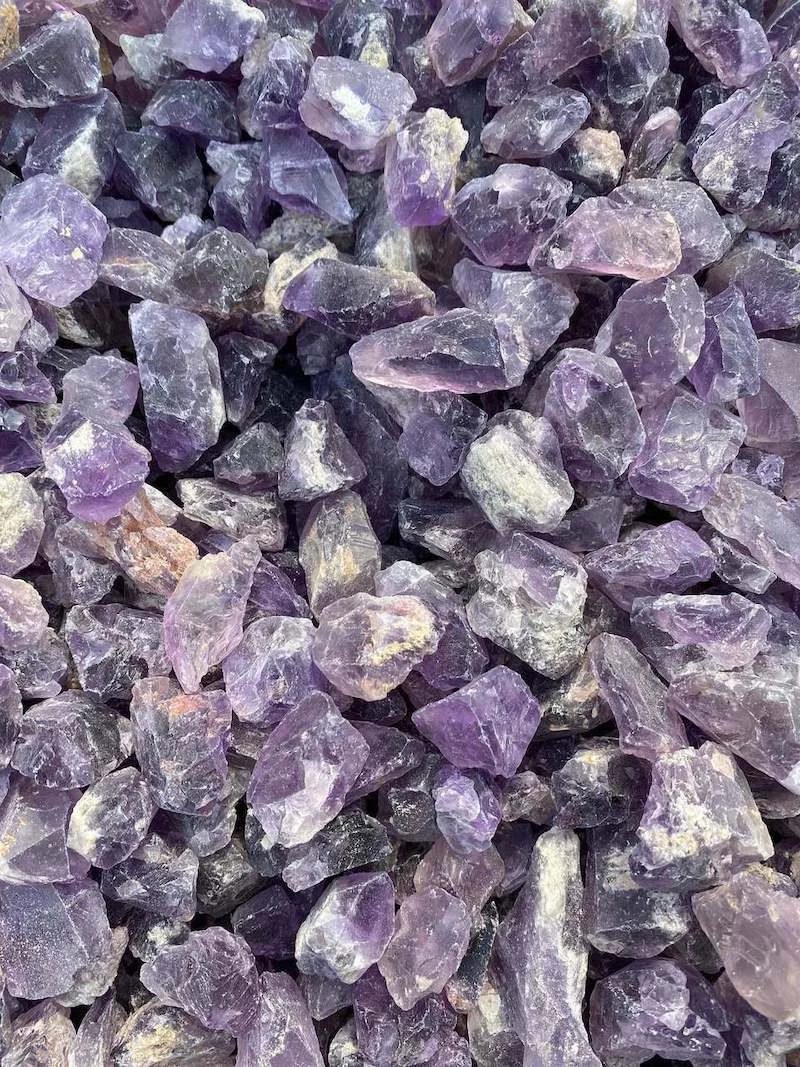
Beyond traditional stone, stainless steel gua sha tools are having a moment. Prized by brands like SACHEU Beauty, this material is non-porous, making it ultra-hygienic and easy to clean. It’s also incredibly durable and naturally cold to the touch, offering an instant cryo-therapy effect that’s amazing for calming inflammation and de-puffing skin without a trip to the fridge.
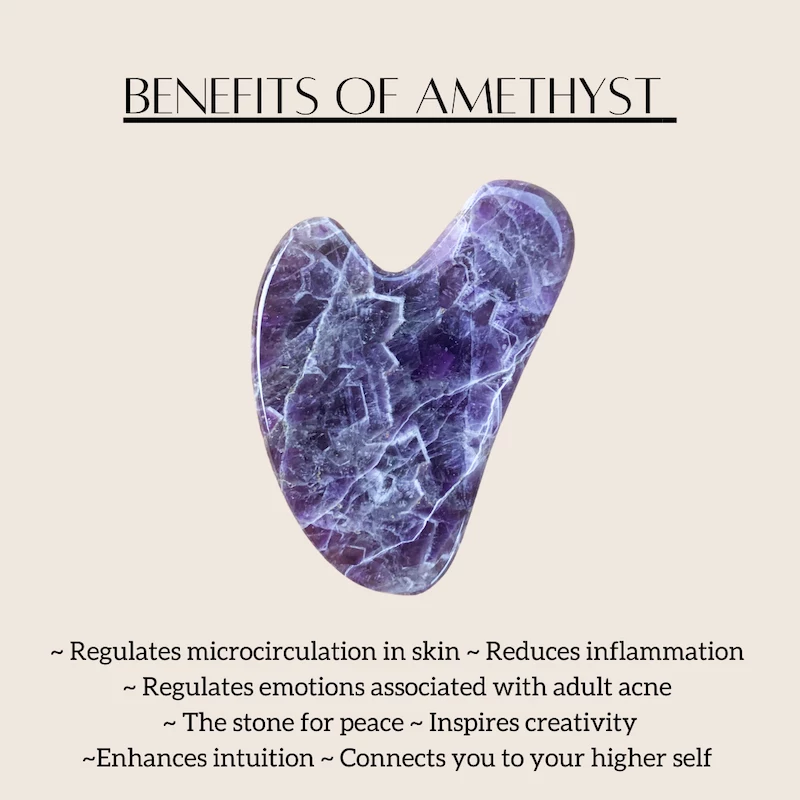
Bian Stone: Darker and often heavier than jade or quartz, Bian stone is said to emit ultrasound pulsations and far-infrared rays. In the hand, it feels incredibly dense and smooth, and it retains a neutral temperature. Many purists, including expert Sandra Lanshin, favor it for its therapeutic feel and historical significance.
Amethyst: Known for its beautiful deep purple hue, amethyst is a type of quartz. It tends to stay cool and feels slightly more ‘grippy’ on the skin than rose quartz, which can be beneficial for really working on tight fascia. It’s a great choice for those prone to tension headaches or jaw clenching.
Both offer a luxurious, effective experience, but your choice might depend on whether you prioritize historical tradition (Bian) or targeted tension relief (Amethyst).
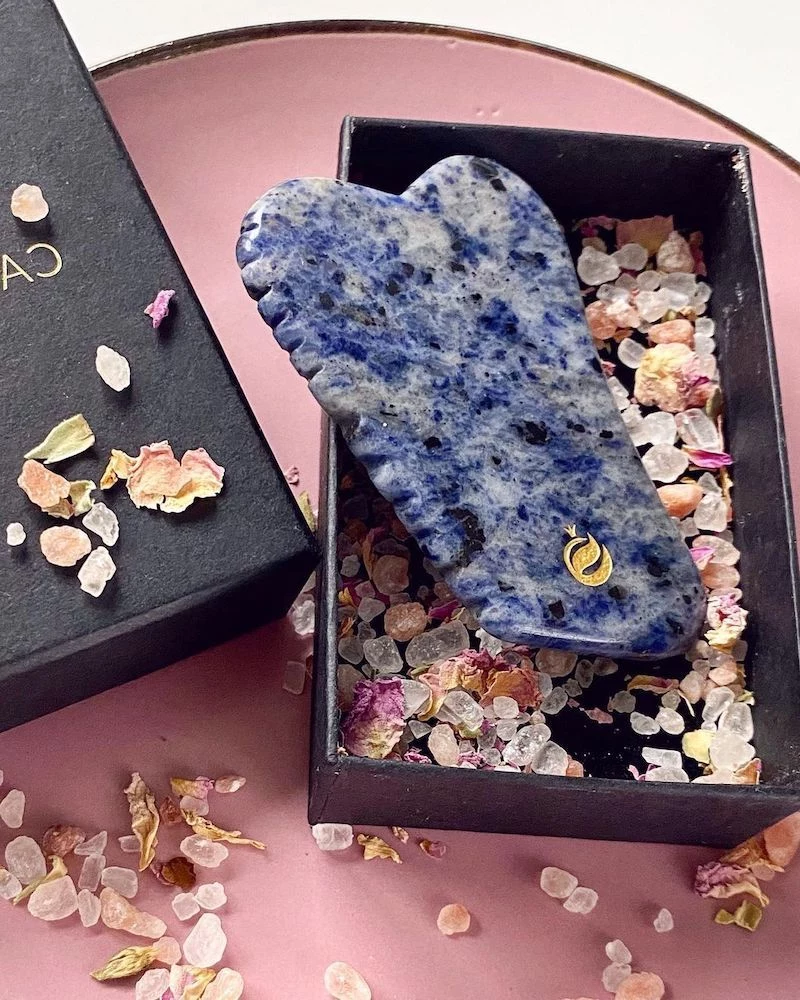
An estimated 80% of jade on the market is fake, often consisting of dyed serpentine or even glass.
To protect your skin and your wallet, be wary of tools with unusually low prices or overly vibrant, uniform colors. Authentic rose quartz often has milky white marbling, and real jade will have subtle, cloud-like variations. A reputable seller like Mount Lai will always be transparent about their sourcing and stone quality.
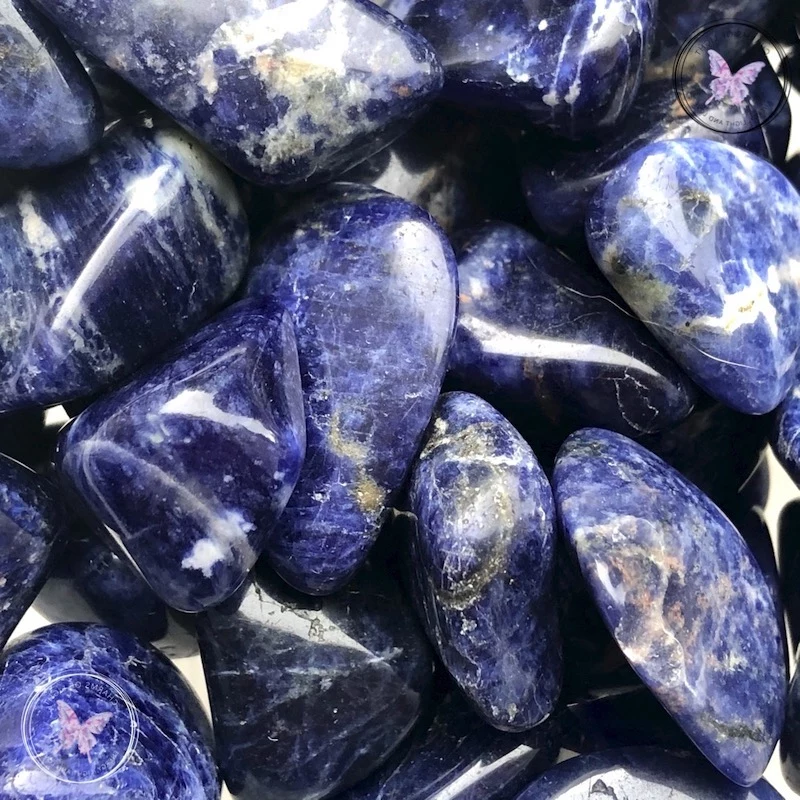
Turn your routine into a ritual. Before you begin, take three deep breaths. Apply your favorite facial oil, warming it between your hands and inhaling its scent. This small moment of mindfulness transforms the practice from a simple skincare step into a meditative experience, calming your nervous system just as much as it soothes your facial muscles.
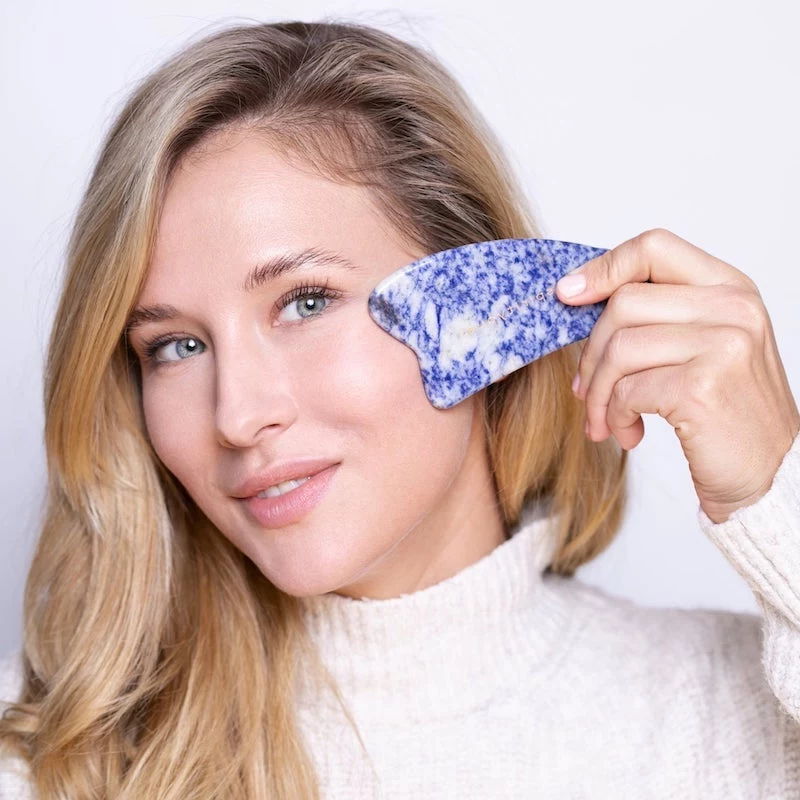
- A freshly cleansed face.
- A clean, dry gua sha tool.
- A generous application of your favorite facial oil or serum.
- A gentle hand and about 5-10 minutes of time.

For an extra de-puffing boost?
Store your gua sha in the refrigerator or a dedicated skincare fridge for at least 10 minutes before use. The pronounced coldness of the stone helps to constrict blood vessels upon contact, providing an immediate tightening and calming effect that’s especially welcome in the morning or on irritated skin.
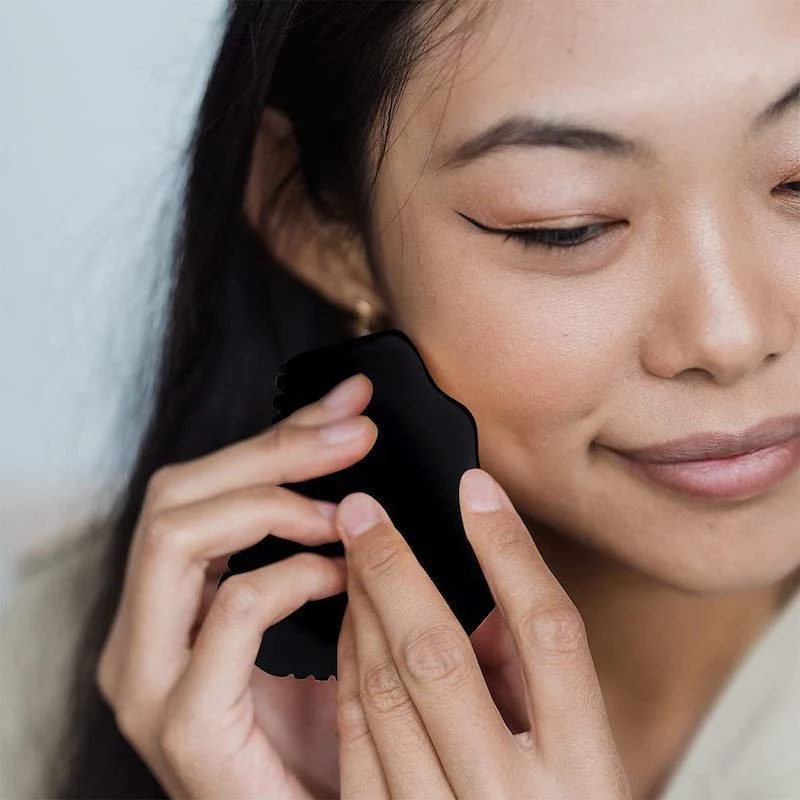
A common mistake is applying too much pressure. The goal of cosmetic gua sha is to gently move lymphatic fluid, which sits just beneath the skin’s surface. Think of it as gently pulling a silk cloth across your skin, not scraping a tense muscle. The tool should be held at a 15 to 45-degree angle, almost flat against the skin, to ensure the right gliding motion.
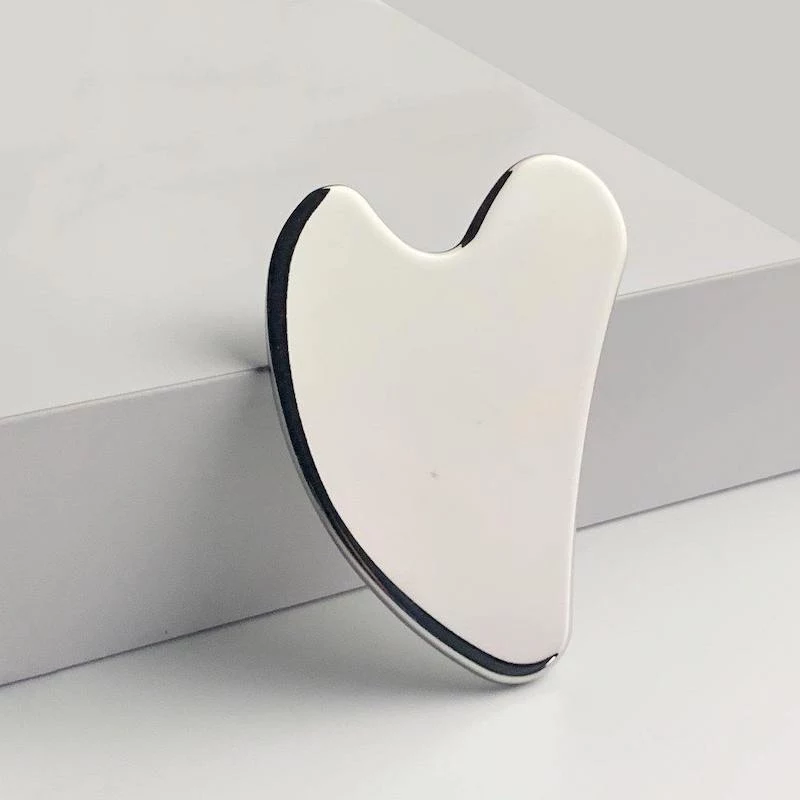
The lymphatic system, unlike the circulatory system, has no central pump. Its fluid is moved by muscle contractions and manual manipulation.
This is precisely why gua sha is so effective. The gentle, directional strokes act as that manual pump for your face and neck, encouraging the drainage of stagnant fluid that contributes to puffiness and a dull complexion.
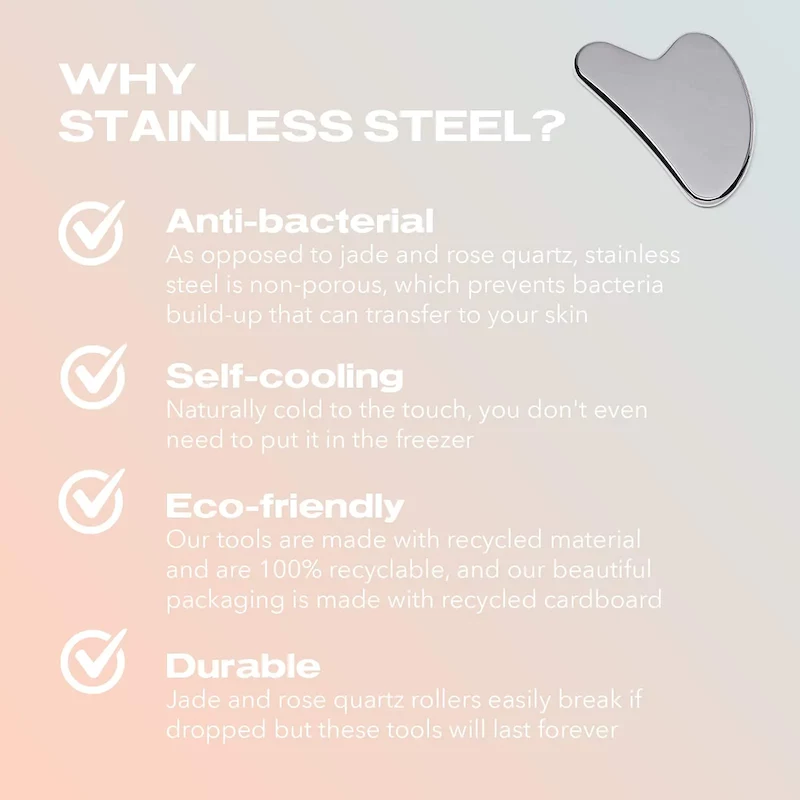
Don’t neglect your neck! The neck is the superhighway for all the lymphatic fluid draining from your face. Always start and end your gua sha routine with gentle, downward strokes along the sides of your neck to open up these pathways. Skipping this step is like trying to clear a traffic jam without opening the exit ramp.
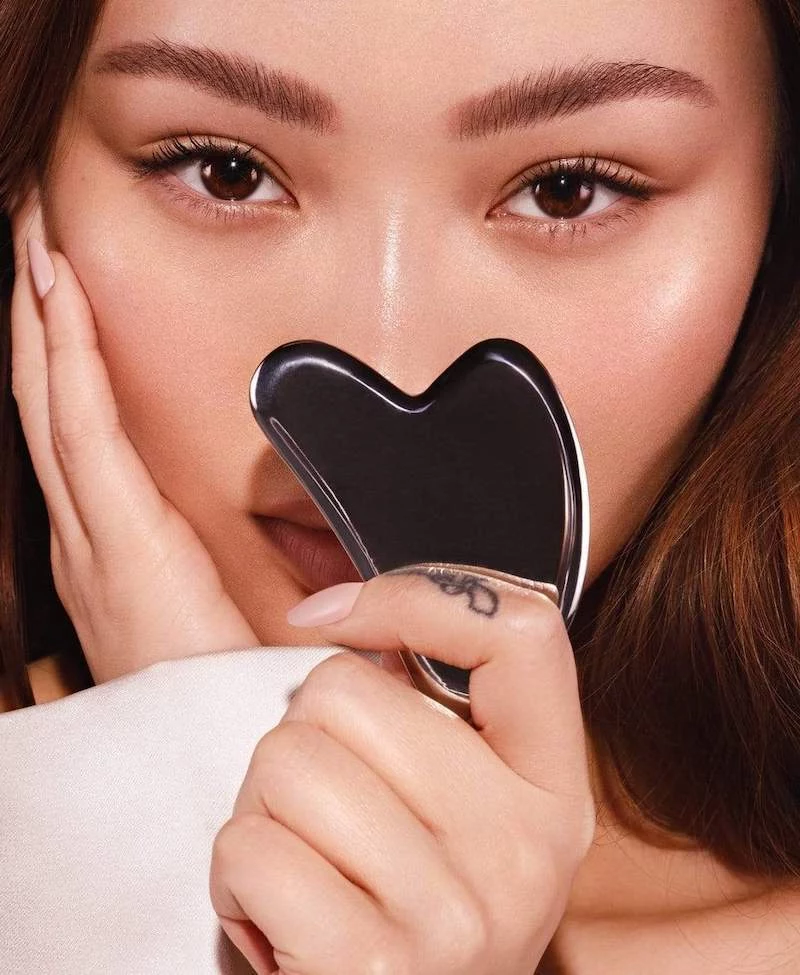
My skin looks really red and blotchy after I use my tool. Is this normal?
A light, pinkish flush that disappears within a few minutes is a sign of healthy circulation. However, if you see persistent redness, red dots (petechiae), or feel any pain, you are likely pressing too hard or working on skin that doesn’t have enough oil for proper glide. Lighten your touch significantly and ensure the tool is held almost flat to the skin.
Cleaning your tool is non-negotiable to prevent bacteria from spreading. After each use, simply wash it with warm water and a gentle soap or your face cleanser. Pat it dry with a clean cloth and store it in a pouch or box to protect it from dust and chipping. This simple step preserves both your tool and your skin’s health.










